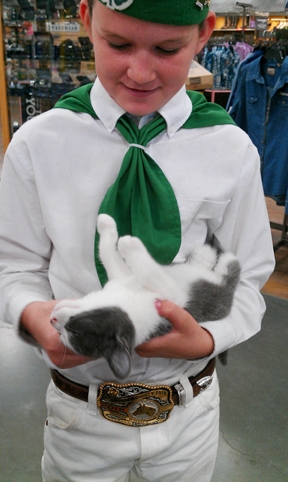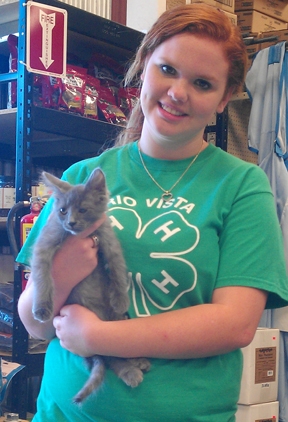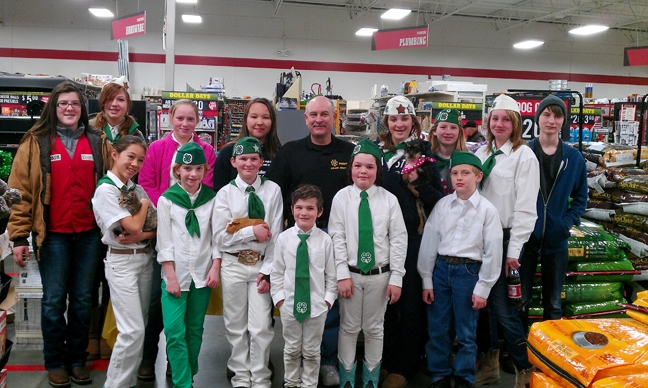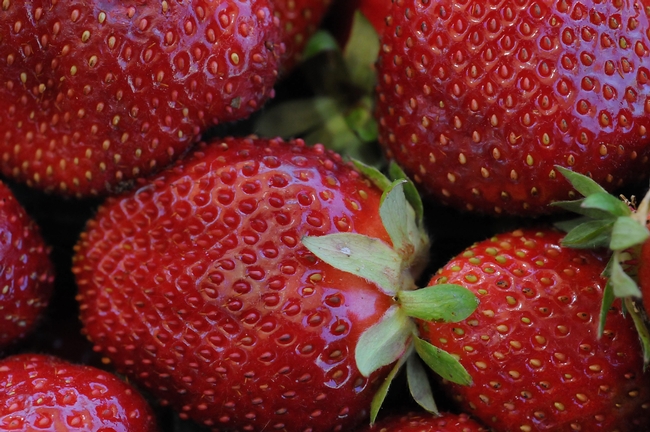Posts Tagged: 4-H
A little love goes a long way
A little love goes a long way, especially when it comes to saving resources, saving lives and teaching youths responsibility.
And a Solano County 4-H project is doing just that — with orphan kittens.
Twenty-one 4-H’ers, all from Dixon, Vacaville, Rio Vista, Vallejo, Elmira or Fairfield, participate in the Solano County 4-H Orphan Kitten Program, doing their part to care for the orphan kittens that arrive at the Solano County Animal Care and Control Facility, Fairfield.
The 4-H’ers foster the felines in their homes until the kittens reach adoption age, and then they seek good homes for them.
The project, which began in the summer of 2011, is “designed to give 4-H members the joy of working with animals and the ability to participate in a rewarding community service project,” said Victoria “Vickie” Pringle, an eight-year adult 4-H leader with the Vaca Valley 4-H Club, Vacaville. She describes it as “a valuable citizenship/service learning project open to 4-H’ers in the fifth grade and above.”
The youths learn about proper kitten care, disease control, cross contamination and proper socialization. Each 4-H’er must attend at least one two-hour training course before being allowed to foster kittens.
The 4-H'ers meet bi-monthly for training, project development and guest speakers, who address topics zeroing in on kitten development and adoption. Once the kitten reaches adoption age, it’s time to find a “forever home” for it. The 4-H’ers assist in the adoption process through off-site adoption events held weekly throughout the county. One venue is Tractor Supply, Dixon.
“This gives the 4-H’ers the full effect of accomplishing something that is a direct result of their hard work and dedication,” Pringle said.
“From August 2011 through June 31, 2012 we had 68 kittens adopted,” she said. “From July 2012 to the present we’ve had 117 adoptions! We currently have only six kittens in foster care but we are gearing up for kitten season that usually runs Easter through Thanksgiving.”
Pringle, a 10-year employee at Solano County Animal Care and Control, launched the project due to a dire need. Every year some 10,300 animals, including approximately 5,000 cats, enter the Solano County Animal Shelter. Of the 5,000 cats, some 1,500 are euthanized “because they are too young to survive in the shelter, as determined by the Humane Society of the United States,” Pringle said.
“Kitten season has always taken its toll on me emotionally just because of the sheer numbers of kittens that come through the doors of the shelter,” Pringle acknowledged. “Before this program, not all these kittens would make it into fosters and the result would be euthanasia. Fosters typically are extremely hard to find and keep, just due to the burnout and fatigue that individuals can go through when caring for numerous animals at one time. It's more like a job than just enjoyment when you have a litter of kittens that need care and socialization on a daily basis.”
Both the kittens and the kids benefit.
“My members take so much pride in raising their kittens!” Pringle said. “I have had adopters write me or call months after adopting just wanting to tell me how much they enjoy their cats. It makes me feel so good.”
Only rarely does a 4-H’er choose to keep a kitten; the youths know they’re raising them for adoption, not for themselves. The shelter provides essential items needed to raise the orphans. This includes isolation caging, food and formula, litter, bedding and toys, as well as veterinarian services.
“The only thing the members have to do is provide time and love,” Pringle said.
More information on the Solano County 4-H Orphan Kitten Project is available from Pringle at (707) 590-0735; victoriapringle@yahoo.com; or on the Facebook page, Solano County 4-H Orphan Kittens.
In front (from left) are Kiarra Madden, Wolfskill 4-H Club, Dixon; Summer Baron, Vaca Valley 4-H; Makenna, Lincoln, and Braydon Caulfield, all from the Roving Clovers 4-H Club, Dixon; and Cody Ceremony, VV 4-H. In back: Tractor Supply employee/4-H member Kristin Clark-Webb, Emma Couvillon, Halie Pringle, Alexis Lynn, all VV 4-H; Solano Sheriff Tom Ferrara, Marley Hardwick, Falyn Voss, Kaitlin Adams, all VV 4-H; and Tyler Sasabuchi,Roving Clovers.
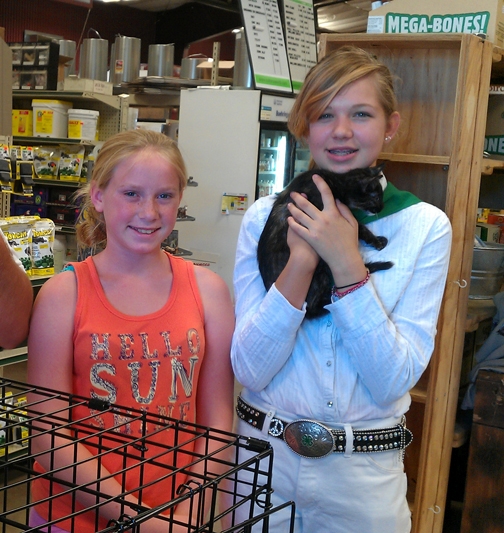
Halie Pringle (left) and Emma Couvillon of the Vaca Valley 4-H Club, Vacaville, with a ready-to-adopt kitten. (Photos courtesy of Victoria Pringle)
4-H members enthralled by science
Hands-on science activities offered as part of 4-H SET (Science, Engineering, Technology) at a El Dorado County park recently were colorful enough to warrant a lengthy feature story in the Mountain Democrat yesterday.
The 4-H'ers experimented with resin to understand how tree sap trapped and preserved insects that flew and crawled 100 million years ago. They examined fossils, viewed a collection of dinosaur bones and went on a fossil fuel scavenger hunt.
“We have great schools, but they don’t have much hands-on experiential learning any more,” Tracey Celio told reporter Dawn Hodson. Celio is the UC Cooperative Extension 4-H youth development coordinator for El Dorado County.
“Our country used to be cutting edge but we’ve lost that in the last 10-15 years due to the outsourcing of jobs and technology,” Celio said. ”Now there is a push to re-energize youth about the opportunities through SET. We want to prepare kids for the 21st century and the jobs available in the 21st century.”
The Buzz About Pesticides
"Reducing the Usage of Bee-Killing Pesticides in My Community." That's the topic--and a good one it is--of the 2013 4-H Honey Bee Essay Contest,...
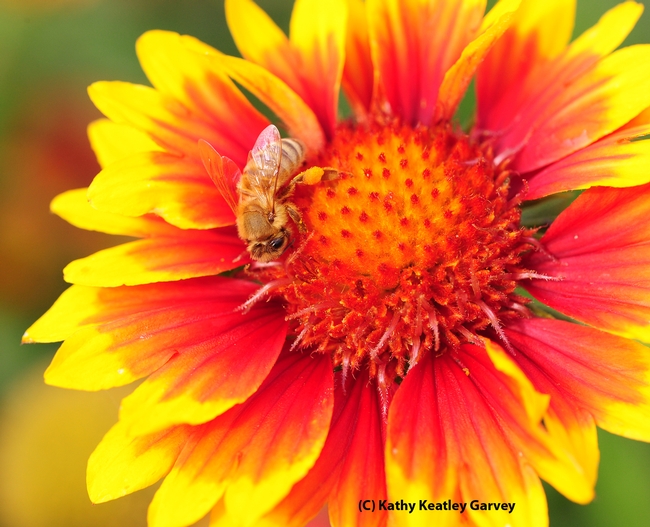
Honey bee on a blanket flower, Galliardia. (Photo by Kathy Keatley Garvey)
4-H member leads tree planting in San Bruno
More than 250 people helped plant trees and other plants in San Bruno on Earth Day to green up a neighborhood charred by a devastating fire a year and a half ago, reported Sergio Quintana on KGO-TV, the ABC affiliate in San Francisco.
The planting event was the brainchild of 13-year-old Julien Levy. Through his efforts, the local 4-H Club, a few Boy Scout troops and resident volunteers turned out to plant the trees.
"It means, kind of, not only a tree and maybe a source of food and fruit, but maybe a token of hope that the renaissance of San Bruno may be beginning," Levy said.
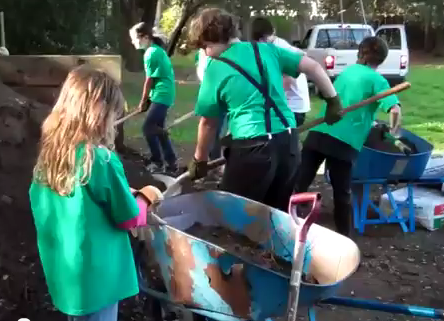
Julien Levy is involved in the 4-H Million Trees Project.
Chandler strawberries get attention
UC strawberry varieties — Chandler in particular — was the topic of a Los Angeles Times article by David Karp.
According to the article, Chandler was introduced in 1983 and was dominant in Southern California production in the late '80s and early '90s, before being surpassed by other varieties. Chandler was bred by Victor Voth and Royce Bringhurst of the University of California.
This year, a well-known strawberry grower among Southern California farmers markets has resumed growing the Chandler variety. Harry's Berries otherwise grows Gaviota and Seascape varieties, both also developed by the UC strawberry breeding program, but will be bringing Chandler berries to markets this year.
4-H Million Trees Project shelters Pacifica Gardens with natives and fruit trees
The Pacifica Tribune
4-H volunteers continue to plant trees for the 4-H Million Trees program, which was started in Pacifica by 4-H member Laura Webber. Reporter Jane Northrop covered 4-H volunteers planting hedge trees at Pacifica Gardens recently.
So far, the paper reports, the program has seen at least 41,000 children plant 350,000 trees.
The program has spurred many 4-H members to propose tree-planting projects at nearby schools, parks and neighborhoods. One of the teens who wrote a grant proposal for another tree-planting event explained why she took on the project.
"I basically wanted to write the grant because I thought it would be a great experience for me and I wanted to help in more ways than just showing up to the plantings. I also wanted to really push myself to do something that I had never done before," said Julia Hurley, a Pacifica 4-H member and eighth-grader.
Fresno farm meeting attracts Asian growers
Fresno Bee
Reporter Robert Rodriguez covered a meeting of Southeast Asian farmers in Fresno, where one of the primary topics was government regulations.
Richard Molinar, UC Cooperative Extension advisor in Fresno, has helped Southeast Asian farmers comply with regulations. At the meeting, he urged farmers to spread the word about how to follow government regulations and who can help.
"Part of this is your responsibility to find out what you need to do," he said. "This not an insurmountable problem."
The meeting was presented by the National Hmong American Farmers, and USDA's Joe Leonard, Jr., was the keynote speaker.


